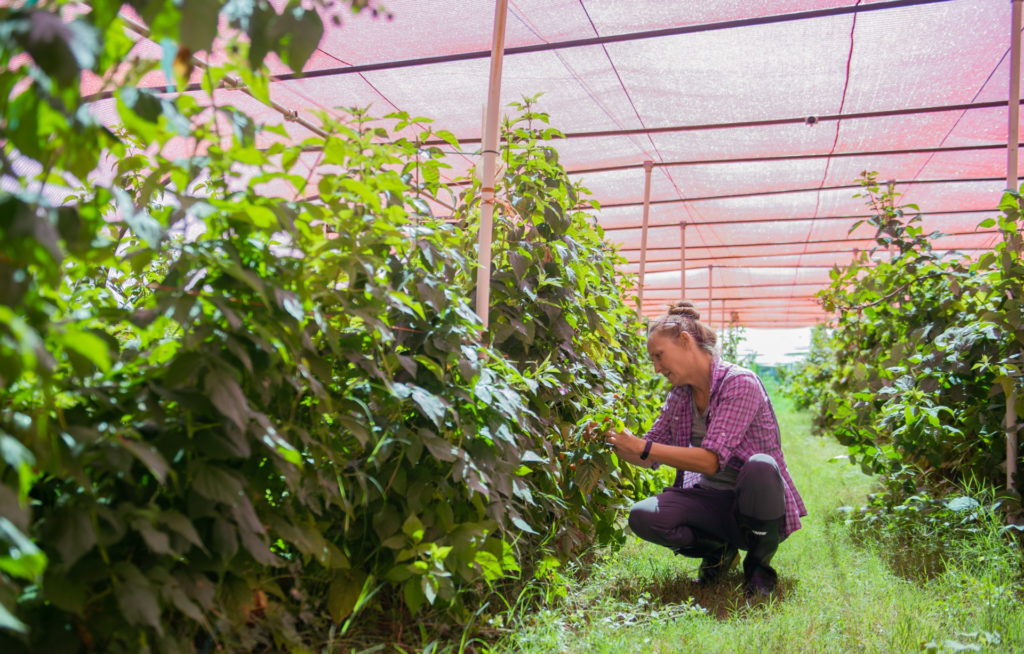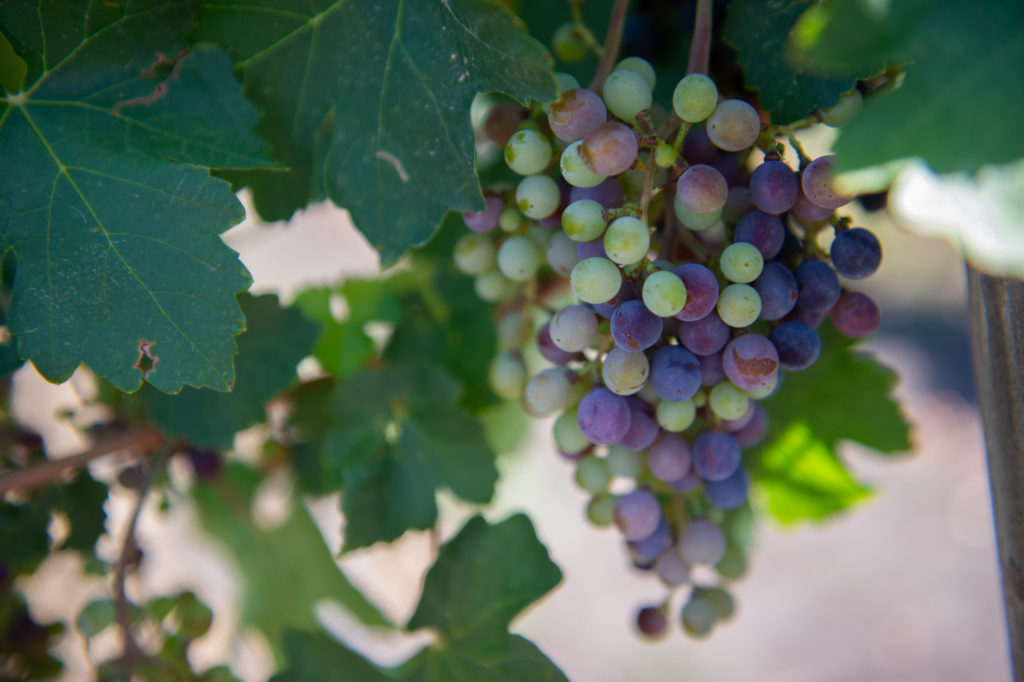Grape expectations: Texas A&M AgriLife and the Texas wine industry
Fruit growers, wine producers and Fredericksburg community strengthened by Texas A&M AgriLife
Nestled comfortably in the Texas Hill Country, Fredericksburg has become well known for its peaceful ambiance and high-quality wines.

This increased attention has promoted Texas Hill Country tourism and helped propel the Lone Star state to among the top five wine-producing states in the U.S., with an annual economic value of $13.1 billion.
The Texas A&M AgriLife Extension Viticulture and Fruit Lab, organizationally homed within the Department of Horticultural Sciences at Texas A&M College of Agriculture and Life Sciences and operated by personnel within Texas A&M AgriLife Extension Service, has been continuously serving the state’s rapidly growing wine industry since 2007.
Located in Fredericksburg, the laboratory specializes in fruit disease-fighting research and identifying ways to enhance the production value for Texas fruit growers. To date, the facility has played an integral role in helping the Texas Hill Country become a top five wine grape-producing region in the U.S. The facility also works collaboratively with Texas A&M AgriLife statewide.
“We are one department with one mission – bring our research, teaching and extension capabilities in the service of our horticulture industries across Texas,” said department head Amit Dhingra, Ph.D.
“The Viticulture and Fruit Lab in Fredericksburg is an important part of our mission and has a proven track record of addressing critical issues faced by the industry. Thanks to the lab, we can proactively ensure that our farmers in the region are ready for future challenges.”
Pierce’s disease and the origin of the lab
The need for this laboratory became evident in early 2000 when many previously unaffected Texas wineries began suffering the effects of Pierce’s disease. This disease can cause large-scale damage to grapevines and significant economic losses to growers. Pierce’s disease threatened the emerging wine industry’s continued growth and long-term success.
In 2000, Ed Hiler, Ph.D., former vice chancellor of Texas A&M AgriLife and dean of the College of Agriculture and Life Sciences, formed a task force led by Jim Kamas, which eventually led to funding from the U.S. Department of Agriculture’s Animal and Plant Health Inspection Service, APHIS, to address this threat.
“The funding for our research to fight Pierce’s disease went from a budget of $150,000 in 2003 to $1.5 million in 2006, and the Viticulture and Fruit Lab was established to facilitate those research projects and find management solutions for the wine growers,” said Kamas, AgriLife Extension fruit specialist, Fredericksburg.
The lab’s future was uncertain when funding was unexpectedly discontinued in 2012. However, thanks to the generosity of donors Tim and Amy Leach of Midland, the facility was purchased and donated back to Texas A&M AgriLife. Tim Leach, who now serves as chairman of The Texas A&M University System Board of Regents, has continued his generous support of the program allowing for the continuation of dedicated service both to viticulture and fruit growers in the region and statewide.
“The Viticulture and Fruit Laboratory at Fredericksburg is playing a vital role in providing education and cutting-edge solutions for Texas’ rapidly growing wine industry, while also adding value to the region’s traditional fruit producers,” Leach said. “Without this facility, none of the critical work done by Texas A&M AgriLife to discover new solutions in combatting Pierce’s disease would have taken place, helping save our emerging wine industry and allowing Texas to become among the top five wine producers in the nation.”
A well-rounded focus on grape and fruit research
The 4-acre field, greenhouse and laboratory conduct research and extension programming primarily for wine grape producers; however, it also provides research and education for the region’s tree and small fruit producers.

“Once we were able to initially get Pierce’s disease under control, we began looking at transitioning into sustainable, long-term management approaches,” Kamas said. “We began investigating novel pathways to disease resistance to overcome some of the limitations Pierce’s disease has on wine grape production. The lab was integral in the trials and eventual releases of new Pierce disease-resistant wine grape varieties. The lab continues to work on new ways to control Pierce’s disease, including efficacy studies on a new bio-control agent and a novel ecological approach to disease management being investigated by Jacy Lewis, laboratory manager.”
In addition to the work that Kamas and Lewis are directing with wine grape production, the lab houses Bri Crowley, viticulture program specialist with AgriLife Extension.
“While Bri’s primary responsibility is AgriLife Extension education and outreach to wine grape growers, she has a strong applied research program dedicated to managing fungal pathogens in grapes,” Kamas said. “These pathogens represent a long overlooked and poorly understood threat to high-quality wine grape production, which is now emerging as one of the most significant hurdles to industry growth.”
Another important aspect of wine grape production being addressed by lab members is sustainable management practices. In addition to Pierce disease management, Lewis has a strong interest in this area of research. Many other growing regions in the country have implemented certification programs for wine grape production to ensure sustainable production practices and increase marketability.
“I feel that this is the next step required to bring Texas wine grape production onto the center stage in the U.S.,” Lewis said.
The lab has also supported other wine and grape research projects, including studies examining dormancy regulation, shade effects, root-stock trials, and efficacy studies for various pesticide products. Laboratory personnel includes Santos Guevara and Leslie Pressler.
“Their work is absolutely integral to our ability to fulfill our mission,” Lewis said. “Santos provides technical assistance in the field as well as building maintenance and farm construction projects. Leslie’s job responsibilities include administrative support, plant care and research assistance. Leslie is an all-around worker. Without her dedicated service, this place simply would not run.”
A coordinated effort to support all fruit growers
“I think an often unrecognized but vital part of our mission is research and outreach in fruit crops other than wine and grapes,” Lewis said while referencing how the region’s fruit growers are facing several challenges with rising production costs and the availability of labor. “We are always looking for ways to help in research, outreach and support in these areas.”
As such, the lab looks at ways to strengthen the labor force within the fruit industry.
“One significant challenge the industry faces is that many of our most knowledgeable and experienced fruit growers are retiring,” Lewis said. “Their children are often not interested in taking over those operations, so most of the new folks interested in horticultural operations are not coming from a traditional agricultural upbringing. Many times, they come to us from urban backgrounds. We are responsible for bridging that gap by providing education and training.”
Additionally, the lab’s research and education programming deals with the sustainable production of high-value fresh fruit, such as raspberries, for direct-to-consumer sales rather than traditional wholesale markets. Fresh fruit crops allow growers to diversify their offerings and market other fresh fruit crops throughout the year to enhance additional revenue opportunities.
Research on sustainable fruit crops focuses on environmentally well-adapted varieties with little to no need for pesticides. These crops provide sustainable ways for fruit growers to diversify their operations and increase profitability. Adding these crops to a fruit growing operation can have direct implications for fruit producers seeking to diversify, manage risk and increase profits.
“We had a 1-acre buffer zone between the lab’s research vineyard and an insect-rearing facility to ensure no insecticide impacted the entomological research,” Kamas said. “One day, as I was mowing the zone, a light bulb went off. We needed to plant crops that we do not have to spray with pesticides, and that moment was when our sustainable fruit crop program began.”
A focus on fruits with high-profit potential
In addition to the central mission of wine grape production, the lab focuses on fruits that offer a high-profit potential and an unsaturated market that can be grown sustainably in our environment.
There is a strong focus on fruits suitable for agrotourism, small acreage holders and new growers.
For example, a specialty crop area the research group is looking into is cane-berry production, including a novel strategy for raspberry production being carried out by Lewis. When put into operation, it would represent both a new and extremely high-value crop for Texas fruit producers with a high potential for organic production.
“We are looking at exciting and novel approaches to protected cultivation that can address some of the challenges to raspberry production associated with high temperatures, low chilling, high light levels and drying winds,” Lewis said. “You can also push a raspberry crop back later into late summer and early to mid-fall.
“Rather than having a crop that will compete with the peach season and available labor, with raspberries, you can extend your production season to help retain labor. It certainly holds potential to offer a profitable advantage for our growers. Some of these raspberries can keep fruiting up until it freezes.”
Additional research areas have included figs, peaches, pears, apricots, olives, pomegranates, table grapes and blackberries, including experimental trials with new pear germplasm that Dhingra brought from his research with his former university.
“We have nothing but positive momentum moving forward to enhance the prospects of growers throughout the region,” Dhingra said. “We have met with several wine producers as well as have ongoing discussions with fruit growers, determining their essential needs and matching our resources to better serve them.”
Overall, Dhingra said the Fredericksburg laboratory facility is committed to serving Texas’ wine grape and fruit growers, ready to provide education and services to meet the challenges that lie ahead.
“We are further positioning our resources and strategic planning to meet these challenges and help propel the multi-billion-dollar economic impact to the Texas economy,” he said.





